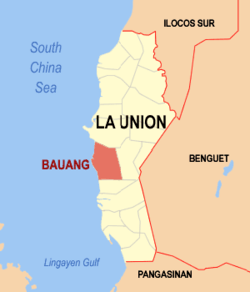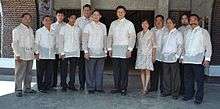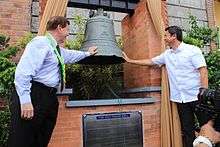Bauang
| Bauang | |
|---|---|
| Municipality | |
| Municipality of Bauang | |
|
Approaching the Bauang town center along the National Highway | |
|
Nickname(s): The Beach Capital and Fruit Basket of the North Grapes Capital of the Philippines | |
| Motto(s): Sulong Bauang! and Rediscovery Bauang | |
 Map of La Union with Bauang highlighted | |
.svg.png) Bauang Location within the Philippines | |
| Coordinates: 16°32′N 120°20′E / 16.53°N 120.33°ECoordinates: 16°32′N 120°20′E / 16.53°N 120.33°E | |
| Country |
|
| Region | Ilocos Region (Region I) |
| Province | La Union |
| District | 2nd District |
| Founded | January 5, 1586 |
| Barangays | 39 (see Barangays) |
| Government [1] | |
| • Type | Sangguniang Bayan |
| • Mayor | Eulogio Clarence Martin P. de Guzman III |
| • Electorate | 41,103 voters (2016) |
| Area [2] | |
| • Total | 73.15 km2 (28.24 sq mi) |
| Population (2015 census)[3] | |
| • Total | 75,032 |
| • Density | 1,000/km2 (2,700/sq mi) |
| Time zone | UTC+8 (PST) |
| ZIP code | 2501 |
| PSGC | 013307000 |
| IDD : area code | +63 (0)72 |
| Climate type | Tropical monsoon climate |
| Income class | 1st municipal income class |
| Revenue (₱) | 249,242,876.39 (2016) |
| Native languages |
Ilocano Tagalog |
| Website |
www |
Bauang, officially the Municipality of Bauang, is a 1st class municipality in the province of La Union, Philippines. According to the 2015 census, it has a population of 75,032 people.[3]
Bauang is 259 kilometres (161 mi) from Metro Manila and 10 kilometres (6.2 mi) from San Fernando, the provincial capital.
The MacArthur Highway runs through the town, which junctions with Naguilian Road, one of the mountain roads leading to Baguio City.
History
In 1590, Bauang started as a settlement. Spanish Friar Agustin Mino was appointed its first minister. In 1765, it became a town and formed part of Pangasinan. Don Francisco delos Reyes sat as its first gobernadorcillo. With the creation of La Union in 1850, Bauang became one of its twelve towns.
Like other towns in the province, Bauang also had its share in the devastating invasions of Moro pirates ("tirong") made series of invasions in Bauang, hence, the rise of watchtowers ("baluarte", by the Gobernadorcillo Don Juan Mallare). In 1890, Bauang "revolucionarios" led by Remigio Patacsil and Mauro Ortiz ousted the Spanish colonizers ("cazadores" or Spanish soldiers) and the "revolucionarios" (Filipinos).
In 1913, however, Bauang barrios were given to San Fernando: Pagudpud, Pagdalagan, Sevilla, Bungro, Tanquigan and Sibuan-Otong. In the Japanese war, heroes of Baunag fought in its beaches, in Lingayen Gulf, Bataan and Corregidor (as USAFIP-NL). The Japanese executed Manuel Arguilla, poet and journalist, Major Alberto O. Fenit (USAFFE) and Bauang Mayor Ambrosio Rimando. A town plaza monument today honors these Bauang heroes.
Bauang is known as the Beach Capital of the Philippines (1970, the shorelines of Baccuit Sur to Pagdalagan Sur). Bauang has a treasure: Research Reef (a dive spot for local and foreign scuba divers).
Bauang regularly hosts the South China Sea Regatta (led by the Royal Hong Kong Yacht Club.)[4]
Etymology
Bauang originated from either two Ilocano words: baoang (meaning "garlic") or buang also means "river split into two" flowing into the sea (in reference to the delta that divides an eponymous river into two).
Bauang has a treasure: Research Reef (a dive spot for local and foreign scuba divers).
Bauang regularly hosts the South China Sea Regatta (led by the Royal Hong Kong Yacht Club.)[4]
Demographics
| Population census of Bauang | ||
|---|---|---|
| Year | Pop. | ±% p.a. |
| 1903 | 10,032 | — |
| 1918 | 12,952 | +1.72% |
| 1939 | 16,304 | +1.10% |
| 1948 | 22,441 | +3.61% |
| 1960 | 26,142 | +1.28% |
| 1970 | 33,307 | +2.45% |
| 1975 | 37,917 | +2.63% |
| 1980 | 41,859 | +2.00% |
| 1990 | 51,573 | +2.11% |
| 1995 | 56,189 | +1.62% |
| 2000 | 63,373 | +2.61% |
| 2007 | 69,837 | +1.35% |
| 2010 | 70,735 | +0.47% |
| 2015 | 75,032 | +1.13% |
| Source: Philippine Statistics Authority[3] [5] [6] [7] | ||
In the 2015 census, the population of Bauang was 75,032 people,[3] with a density of 1,000 inhabitants per square kilometre or 2,600 inhabitants per square mile.
Local government
Just as the national government, the Bauang's municipal government is divided into three branches: executive, legislative and judiciary. The judicial branch is administered solely by the Supreme Court of the Philippines. The LGUs have control of the executive and legislative branch.
The executive branch is composed of the mayor and the barangay captain for the barangays.[8] The legislative branch is composed of the Sangguniang Bayan (town assembly), Sangguniang Barangay (barangay council), and the Sangguniang Kabataan for the youth sector.
The seat of Government is vested upon the Mayor Eulogio Clarence Martin P. De Guzman who holds office at the Bauang Town hall. The Sanguniang Bayan is the center of legislation.
Barangays
| Rank | Barangay | Population | Rank | Barangay | Population | Rank | Barangay | Population | |
|---|---|---|---|---|---|---|---|---|---|
| 1 | Central East (Poblacion) | 4,249 | 15 | Dili | 1,674 | 29 | Lower San Agustin | 1,123 | |
| 2 | Acao | 4,233 | 16 | Payocpoc Norte Oeste | 1,633 | 30 | Bagbag | 1,121 | |
| 3 | Central West (Poblacion) | 3,951 | 17 | Ballay | 1,608 | 31 | Casilagan | 1,085 | |
| 4 | Paringao | 3,850 | 18 | Cabalayangan | 1,537 | 32 | Upper San Agustin | 1,053 | |
| 5 | Quinavite | 3,417 | 19 | Pudoc | 1,455 | 33 | Bawanta | 998 | |
| 6 | Santiago | 3,373 | 20 | Urayong | 1,455 | 34 | Palintucang | 973 | |
| 7 | Pugo | 2,703 | 21 | Nagrebcan | 1,443 | 35 | Guerrero | 967 | |
| 8 | Pagdalagan Sur | 2,553 | 22 | Santa Monica | 1,373 | 36 | Disso-or | 946 | |
| 9 | Payocpoc Sur | 2,528 | 23 | Palugsi-Limmansangan | 1,357 | 37 | Cabisilan | 693 | |
| 10 | Calumbaya | 2,381 | 24 | Bucayab | 1,279 | 38 | Carmay | 466 | |
| 11 | Baccuit Norte | 2,244 | 25 | Pottot | 1,237 | 39 | Pilar | 379 | |
| 12 | Baccuit Sur | 2,095 | 26 | Payocpoc Norte Este | 1,212 | Bauang Total | 70,735 | ||
| 13 | Parian Este | 1,905 | 27 | Boy-utan | 1,177 | ||||
| 14 | Taberna | 1,868 | 28 | Parian Oeste | 1,141 | ||||
Elected municipal officials 2013-2016

- Mayor: Eulogio Clarence Martin P. de Guzman III
- Vice Mayor: Bonifacio G. Malinao Sr.
- Councilors:
- Alexander Romeo de Guzman Obong
- Veronica T. Bernardo
- Bonifacio A. Malinao Jr.
- Raymond Corpuz Ganaden
- Gabriel A. Sotto
- Edgardo B. Balagot
- Napoleon C. Dumo
- Wilmar Johnny A. Lopez
- David Ballesil ABC President
Tourism
Festivals and local events
| Date | Name |
|---|---|
| January 5 | Foundation Anniversary |
| Holy Week | Electric Fluvial Parade (Stations of the Cross) |
| April (First Friday) | Kalgaw Summer Beach Sports Festival |
| June 29 | Patronal Fiesta (Sts. Peter and Paul) |
| First Saturday of October | OktoberFest |
| October 31 | Panagkakararua Festival |
| December 16 to January 5 | Baggak Festival |
The natives, who are predominantly Roman Catholic, speak Iloko, Filipino, and English. The primary industries are farming, fishing, power plant and quarrying.
Bauang's main products are rice, corn, guapples and native grapes (barangays Payocpoc, Santiago, Bagbag and Urayong), mango, lowland vegetables, livestock, tobacco, marine products, saltwater fish politically.
Guapple by-products are also sold in Bauang: bread, buchi, chunky, cocktail, cookies, cupcake, dried, empanada, espasol, flan, guinataan, gulaman, inipit, jam, jelly, juice, kutsinta, pastilles, maja, marmalade, oatmeal, pie, yema, polvoron, preserved, rolls, siopao, tarts, turrones, macaroons, bars, and fingers as pasalubongs.
Beaches and sunsets of Bauang
Bauang is known for its fine-sand beaches, including Taberna, Baccuit Sur and Norte, Paringao, and Pagdalagan Sur beaches.
Bauang's beaches are accessible from several resorts: Bali Hai Beach Resort (Paringao), Long Beach Resort, Coconut Grove Beach Resort and San Luis del Mar (Baccuit Norte), inter alia.[10]
Saints Peter and Paul Parish Church
The Sts. Peter & Paul Parish Church (canonically erected on 25 April 1587 by the Augustinian missionaries) celebrates its fiesta every June 29. It is under the jurisdiction of the Roman Catholic Diocese of San Fernando de La Union (Dioecesis Ferdinandopolitana ab Unione, Suffragan of Lingayen – Dagupan, which was created on January 19, 1970 and erected on April 11, 1970, comprising the Civil Province of La Union, under the Titular, St. William the Hermit, February 10). It has been headed by the Most Rev. Rodolfo F. Beltran, D.D., bishop since 18 January 2013. The Church is under a diocese of the Latin Rite of the Roman Catholic Church in the Philippines from the Archdiocese of Nueva Segovia.[11][12] The Church is also under the pastorship of Rev. Fr. Perpetuo Concepcion. Its Parochial Fiesta is on April 26.[13][14][15]
The Saints Peter and Paul Church is one of the oldest church in the Philippines. Damaged by the 1892 earthquake, the Church was restored in 1895. Damaged again in 1944, the stone convent was destroyed in 1955. The Sacred Heart School now stands from the old Convent.
The Church has a rectangular four-storey bell tower (with two bells, restored with cement and hollow blocks in 1973). The Church interior was painted in 1978. The 16 July 1990 quake destroyed the facade which was later rebuilt. In 1901 US Army’s (then) Lt. Col. Thomas Barry, who was chasing Emilio Aguinaldo during the Philippine-American War, took the bell as a "token souvenir" and later gave the bell to his alma mater, the United States Military Academy at West Point, New York, where it was housed for over a century. The bell was ceremoniously returned to the Philippines in May 2016 to be reinstalled in the Peter and Paul Church.[16][17][18]
The Grotto of our Lady of Lourdes is at the foot of the Church.
400-year old San Pedro Bell

On May 23, 2016, the 400-year old "San Pedro" bell made from alloy of gold, silver and copper has been returned to the Saints Peter and Paul Parish Church, after American soldiers during the Philippine-American War in 1901 took it from the church to West Point Academy in New York.[19]
Education
Elementary schools:
- Acao Elementary School - Brgy. Acao
- Baccuit Elementary School - Brgy. Baccuit Sur
- Bagbag Elementary School - Brgy. Bagbag
- Ballay Elementary School - Brgy. Ballay
- Baratao Elementary School - Sitio Baratao, Brgy. Acao
- Bauang North Central School - Brgy. Central East
- Bawanta Elementary School - Brgy. Bawanta
- Bigbiga Elementary School - Sitio Bigbiga, Brgy. Lower San Agustin
- Boy-Utan Elementary School - Brgy. Boy-Utan
- Bucayab Elementary School - Brgy. Bucayab
- Cabalayangan Elementary School - Brgy. Cabalayangan
- Calumbaya Elementary School - Brgy. Calumbaya
- Casilagan Integrated School - Brgy. Casilagan
- Guerrero Elementary School - Brgy. Guerrero
- Palugsi-Limmansangan Elementary School - Brgy. Palugsi-Limmansangan
- Parian Este Elementary School - Brgy. Parian Este
- Parian Oeste Elementary School - Brgy. Parian Oeste
- Paringao Elementary School - Brgy. Paringao
- Payocpoc Elementary School - Brgy. Payocpoc Sur
- Pudoc Primary School - Brgy. Pudoc
- Pugo Elementary School - Brgy. Pugo
- Quinavite Elementary School - Brgy. Quinavite
- Saint Anthony Montessori Educational Network, Inc. (Private) - Brgy. Central East
- Saints Peter and Paul Learning Center (Private) - Brgy. Central East, beside the Church
- San Agustin Elementary School- Brgy. Upper San Agustin
- Santiago Elementary School - Brgy. Santiago
- Sta. Monica Elementary School - Brgy. Sta. Monica
Secondary schools:
- Baccuit National High School - Brgy. Baccuit Sur
- Ballay National High School - Brgy. Ballay
- Bawanta National High School - Brgy. Bawanta
- Casilagan Integrated School - Brgy. Casilagan
- Don Eulogio de Guzman Memorial National High School - Brgy. Calumbaya
- Eulogio Clarence de Guzman Junior Memorial National Vocational HS (formerly Acao National High School) - Brgy. Acao
- Paringao National High School - Brgy. Paringao
- Sacred Heart School (Private) - Brgy. Central East
- Saint Anthony Montessori Educational Network, Inc. (Private) - Brgy. Central East
Tertiary:
- La Union Colleges of Science and Technology (Private) - Brgy. Central West
- Saint Louis College Development Center (Private)
Industries, infrastructure facilities and utilities
1590 Energy Corporation The Bauang Diesel Power Plant formerly owned by the Bauang Private Power Corporation (BPPC) is a diesel-fired power plant which commenced operations in July 1995 with a 215 MW-capacity. State-owned National Power Corporation and the First Private Power Corp. (FPPC) entered into a Build-Operate-Transfer Agreement for the BPCC for a period of 15 years.
On July 26, 2010, after the BOT expiration, it was turned-over to the NAPOCOR and the Power Sector Assets and Liabilities Management Corp. (PSALM) and later to the Provincial Government of La Union. BothViviant Energy Corporation and Gigawatt Power, Inc. under the 1590 Energy Corp. operates the Bauang power facility provide the additional supply to the Luzon grid.
Major facilities inside the plant include a substation, two 100,000 bbl steel fuel storage tanks, sludge treatment plant, and five auxiliary buildings consisting of an administration building (812 sq.m), maintenance building (981 sq.m), warehouse building (591 sq.m), guest house (583 sq.m), bunk house (660 sq.m), and a canteen (550 sq.m).
The world’s largest medium speed power station in Bauang maintains an IMS certification for ISO 9901:2000, ISO 14001:2004, and OHSAS 18001 from Certification International.
PLDT Asia-Pacific Cable Network (APCN) in Baccuit Sur A Digital Optical Cable System for telecommunications services linking Hong Kong, Indonesia, Japan, Korea, Malaysia, Taiwan, Thailand, Singapore, and the Philippines is strategically located at the coastline barangay of Baccuit Norte in Bauang, La Union.
The facility, owned by the Philippine Long Distance Telecommunications Company, aims to benefit the users of telecommunications services and consequently stimulate the rapid expansion of business and government intercourse between the Philippines and the foreign countries to be served.
Notable people from Bauang
- Manuel Arguilla, one of the Philippines' most influential English writers, grew up in Bauang's Barrio Nagrebcan[20][21]
- Antonio O. Floirendo Sr. (1915-2012), entrepreneur, chairman of the Anflocor Group of Companies[22]
Gallery
- Municipal hall
- Police station and Legislative building
- The landmark Bauang Farmers‑Fisher's Monument
- Bauang Commercial Center (public market)
- Town plaza overlooking Sts. Peter & Paul Parish Church
References
- ↑ "Municipality". Quezon City, Philippines: Department of the Interior and Local Government. Retrieved 31 May 2013.
- ↑ "Province: La Union". PSGC Interactive. Quezon City, Philippines: Philippine Statistics Authority. Retrieved 12 November 2016.
- 1 2 3 4 Census of Population (2015). "Region I (Ilocos Region)". Total Population by Province, City, Municipality and Barangay. PSA. Retrieved 20 June 2016.
- 1 2 "Municipality of Bauang, La Union Philippines".
- ↑ Census of Population and Housing (2010). "Region I (Ilocos Region)". Total Population by Province, City, Municipality and Barangay. NSO. Retrieved 29 June 2016.
- ↑ Censuses of Population (1903–2007). "Region I (Ilocos Region)". Table 1. Population Enumerated in Various Censuses by Province/Highly Urbanized City: 1903 to 2007. NSO.
- ↑ "Province of La Union". Municipality Population Data. Local Water Utilities Administration Research Division. Retrieved 17 December 2016.
- ↑ Local Government Code of the Philippines, Book III Archived 2009-03-26 at the Wayback Machine., Department of Interior and Local Government official website
- ↑ "2010 Census of Population and Housing: Population Counts - Cordillera Administrative Region" (PDF). Philippine Statistics Authority, April 4, 2012. Archived from the original (PDF) on 26 June 2015. Retrieved 16 November 2014.
- ↑ "Municipality of Bauang, La Union Philippines".
- ↑ "Catholic Directory of the Philippines - Claretian Communications Foundation, Inc". Archived from the original on 2013-12-31.
- ↑ David M. Cheney. "San Fernando de La Union (Diocese) [Catholic-Hierarchy]".
- ↑ Local Government Units: Municipality of Bauang - Province of La Union :: Official Website Archived July 10, 2012, at the Wayback Machine.
- ↑ Charmaine (5 October 2017). "[RMM] Instituto Nuestra Senora de la Merced de Barcelona".
- ↑ http://www.church.nfo.ph/list-of-parishes-roman-catholic-diocese-of-san-fernando-de-la-union/
- ↑ "SAN PEDRO BELL RETURNED TO PH AFTER 101 YEARS AT WEST POINT CHAPEL". balitangamerica.tv. May 2, 2016.
- ↑ "US returns La Union's 400-year-old bell". The Philippine Star. May 19, 2016.
- ↑ "West Point, NY chapel returns San Pedro bell to Bauang, La Union church". Asian Journal. May 6, 2016.
- ↑ Beleo, Erwin G. (23 May 2016). "400-year old San Pedro bell returns to its original home". Manila Bulletin. Retrieved 2 October 2016.
- ↑ José, Francisco Sionil (2005), Alejandro Padilla, ed., Termites in the Sala, Heroes in the Attic:Why We Are Poor, Ermita, Manila: Solidaridad Publishing House, ISBN 971-8845-41-0
- ↑ José, Francisco Sionil (December 8, 2003), "A Sense of Time and Place", Philippine Graphic
- ↑ Torrevillas, Domini M. (July 5, 2012). "Banana magnate passes away". Philippine Star. Retrieved July 10, 2012.
Sources
- "Brief History and Profile of Bauang". Archived from the original on March 18, 2007. Retrieved May 2, 2006.
External links
| Wikimedia Commons has media related to Bauang. |